UKPSC Prelims Paper 2 Mock Test - 1 - UKPSC (Uttarakhand) MCQ
30 Questions MCQ Test UKPSC Mock Test Series 2024 - UKPSC Prelims Paper 2 Mock Test - 1
Directions: Refer to the table below and answer the questions that follow. Salary range for an organisation for all male and female employees
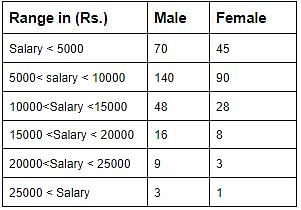
What is the approximate average monthly income of males in the organisation?

Directions: Refer to the table below and answer the questions that follow. Salary range for an organisation for all male and female employees
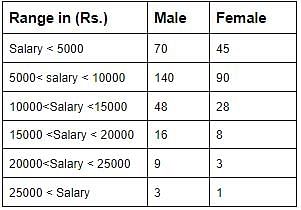
What is the minimum average monthly income (approximately) of the female employees who do not earn less than Rs 5000?

| 1 Crore+ students have signed up on EduRev. Have you? Download the App |
Directions: Refer to the table below and answer the questions that follow. Salary range for an organisation for all male and female employees
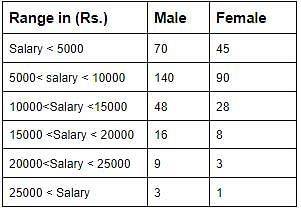
What is the ratio of the maximum average monthly salaries of all the male employees to all the female employees who earn equal?

Directions: Refer to the table below and answer the questions that follow. Salary range for an organisation for all male and female employees
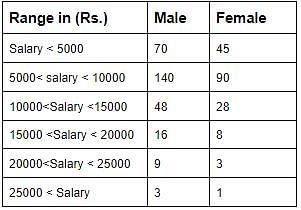
What percent of the total employees earn less than Rs 20000 but more than or equal to Rs 10000 as their monthly salary?
A can finish a work in 24 days, B in 9 days and C in 12 days. B and C start the work but are forced to leave after 3 days. The remaining work was done by A in?
9 kids can finish a bit of work in 360 days. 18 men can finish the same work of piece in 72 days and 12 ladies can finish it in 162 days. In how long can 4 men, 12 ladies and 10 kids together finish the bit of work?
A works twice as fast as B. If two can together complete a bit of work in 12 days, then B alone can do it in:
Directions for the following (one) item:
Read the following passage and answer the item that follow. Your answer to this item should be based on the passage only.
The Paris Agreement adopted last year marks the beginning of a new age in climate change response. The global climate pact will have a major impact on public health policy as countries take measures on adaptation and mitigation. Strengthening adaptation is a must in the face of climate change. This includes plans to protect human health from air pollution, heat waves, floods, droughts and the degradation of water resources.
Q. Which of the following option(s) is/are valid statement(s) that support the emphasis on adaptation as suggested in the passage?
1. At present, more than 7 million deaths occur worldwide every year due to air pollution.
2. In 2017, the world had 124 acutely hungry people
3. Epidemics such as cholera, dengue and extreme weather events such as heat waves and floods have increased
Select the correct code from below:
Amit covers one-fourth of the total distance at 20 kmph, one-fourth at 10 kmph and rest of his journey at 80 kmph. Find Amit's average speed for the whole distance?
If Rahul played 25 singles badminton matches and won 17 out of these. If there were no tied or drawn matches, then what is the ratio of the number of matches won by Rahul to the number of matches he lost?
Directions: These questions are based on the following pie-charts.
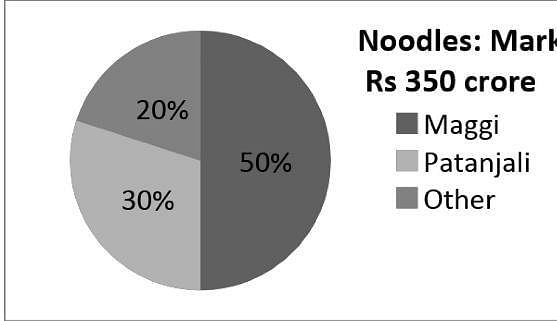
Cheese: Market size 120 crore
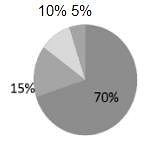
- Amul
- Vadilal
- Mother Dairy
- Other
Q. If Maggi produces Superior and Ordinary types of its products - there ratio is 2 : 3 respectively, find the total market share (in Rupees crore) of the Ordinary type of products of Maggi.
Directions: These questions are based on the following pie-charts.
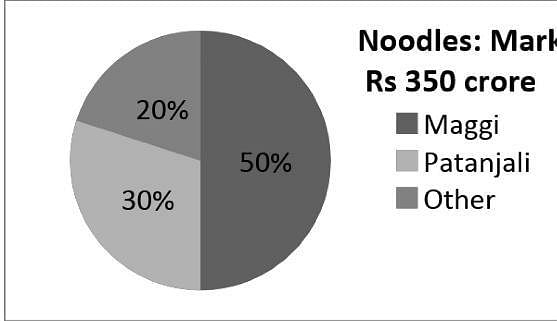
Cheese: Market size 120 crore

- Amul
- Vadilal
- Mother Dairy
- Other
Q. The elders in Kanpur recalled that a couple of decades ago when the population of the town was just 30000 (present population = 55000), they used to spend Rs 125 per capita for these items as well as bread. At that time, the total market share of bread must have been lakh rupees. Assume per capita expenses growth at 1% p.a.
Directions: These questions are based on the following pie-charts.
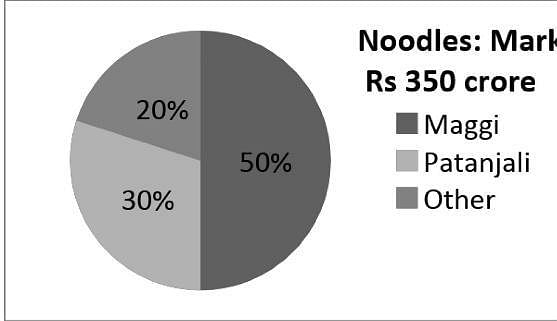
Cheese: Market size 120 crore
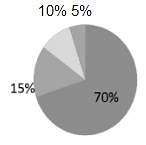
- Amul
- Vadilal
- Mother Dairy
- Other
Q. If Kisan diversified into the Noodles market, capturing 15% of the market held by Maggi, what would be the share of Kisan in the entire food market given (Rs crores)?
Directions: These questions are based on the following pie-charts.

Cheese: Market size 120 crore

- Amul
- Vadilal
- Mother Dairy
- Other
Q. If Maggi produces Superior and Ordinary types of its products - noodles and ketchup - in the ratio of 3 : 2 and 7 : 3 respectively, find the total market share (in Rupees crore) of the Ordinary type of products of Maggi.
The wages of Santhosh and Revathi are in the ratio ratio 6:5. If the wages of each is increased by Rs.6000, the new ratio becomes 38:35. What is Revathi' s present salary?
For every 2 chocolate Mahesh gets Umesh is given 3 chocolate. If the total number of chocolate distributed to them is 65, then find the number of chocolates Umesh received?
A trader allows two successive discounts of 10% and 20%. If he sells the article for Rs. 144, then what is the marked price of the article?
It has long been known that the rate of oxidative metabolism (the process that uses oxygen to convert food into energy) in any animal has a profound effect on its living patterns. The high metabolic rate of small animals, for example, gives them sustained power and activity per unit of weight, but at the cost of requiring constant consumption of food and water. Very large animals, with their relatively low metabolic rates, can survive well on a sporadic food supply, but can generate little metabolic energy per gram of body weight. If only oxidative metabolic rate is considered, therefore, one might assume that smaller, more active, animals could prey on larger ones, at least if they attacked in groups. Perhaps they could if it were not for anaerobic glycolysis, the great equalizer. Anaerobic glycolysis is a process in which energy is produced, without oxygen, through the breakdown of muscle glycogen into lactic acid and adenosine triphosphate (ATP), the energy provider. The amount of energy that can be produced anaerobically is a function of the amount of glycogen present—in all vertebrates about 0.5 percent of their muscle’s weight. Thus, the anaerobic energy reserves of a vertebrate are proportional to the size of the animal. If, for example, some predators had attacked a 100-ton dinosaur, normally torpid, the dinosaur would have been able to generate almost instantaneously, via anaerobic glycolysis, the energy of 3,000 humans at maximum oxidative metabolic energy production. This explains how many large species have managed to compete with their more active neighbours: the compensation for a low oxidative metabolic rate is glycolysis.
Q. The passage suggests that the total anaerobic energy reserves of a vertebrate are proportional to the vertebrate’s size because
One-way governments can decrease air pollution is to impose a tax on industrial carbon dioxide emissions. It is not clear how high taxes imposed on carbon dioxide emissions should be or what its economic and environmental implications would be. At first glance, it is not difficult to estimate roughly the size of the tax needed to effect a given level of emission reduction. One writer estimate, for example, that a tax of 41 percent on the price of coal, 33 percent on oil, and 25 percent on gas would reduce the United Kingdom’s emissions by 20 percent (using 1988as the base year) by the year 2005, the target recommended by the 1988 Toronto Conference. These numbers are based on the assumption that all countries will behave cooperatively in imposing a carbon tax.
Q. According to the passage, the size of the carbon tax levied on a given fuel would vary with the
One-way governments can decrease air pollution is to impose a tax on industrial carbon dioxide emissions. A significant decrease is achieved only when all countries will behave cooperatively in imposing carbon tax. There are very strong reasons to believe that cooperation would be difficult to win. If most countries cooperated, then any country that chose not to cooperate would be advantaged: it would have no abatement costs, and the effect on the environment of its defection would be relatively small. Because of this "free rider" effect, cooperation on a scale needed to reduce carbon dioxide emissions might prove elusive. Should countries act unilaterally to curb emissions? If a country were to act unilaterally, the benefits would be spread across the globe, whereas the costs would fall solely on the country taking the action. The action would reduce emissions globally, and the effect of this would be to reduce the benefit other countries would receive if they reduced emissions. As a consequence, other countries would have less incentive to reduce emissions and would probably emit more carbon dioxide than they would have if the unilateral action had not been taken. The entire effect of the emission reduction may not be lost, but it would surely be diminished by this free-riding behaviour.
Q. Which one of the following is most parallel to the "free rider” effect mentioned in passage?
Directions for the following (one) item:
Read the following passage and answer the item that follow. Your answer to this item should be based on the passage only.
We have hard work ahead. There is no resting for any of us till we redeem our pledge in full fill we make all the people of India what destiny intends them to be. We are citizens of a great country, on the verge of bold advance, and we have to live up to that high standard. All of us, to whatever religion we may belong, are equally the children of India with, equal rights, privileges and obligations. We cannot encourage communalism or narrow mindedness, for no nation can be great whose people are narrow in thought or action.
Q. The challenge the author of the above passage throws to the public is to achieve
A and B invested in a business. They earned some profit which they divided in the ratio of 2 : 3. If 'A' invested Rs. 40,000, what is the amount invested by B?
Ramya and Sheela are partners in a business, Ramya invests Rs, 35,000 for 8 months and Sheela invests Rs. 42,000 for 10 months. Out of a profit of Rs. 31,570, What is Ramya's share ?
What is the sum of all natural numbers between 100 and 200 which are multiples of 3?
The Christmas season, of course, is an appropriate time of year to reflect on busyness. The time between Christmas and New Year should be a time for reflection and relaxation, but is often stressed. Rather than taking time out after the busyness of Christmas preparations, many of us find ourselves in a whirlwind of sales shopping, sporting activities, or visiting friends or family. One form of busyness is replaced by another. Being busy has become so ubiquitous it has come to mean everything and nothing. As more people identify with the problem of busyness, some of us seek advice from time management experts about how to manage our busy lives. But data suggests that we are not as busy as we think we are. Social scientists who, specialise in researching every day time- use can compare trends in how we spend time from the 1960s onwards. The UK expert on time use, Jonathan Gershuny, claims that actual time spent in work has not increased since the 1960s - but what we mean by busyness has changed over time. In his view, busyness has become a badge of honour. There are a number of reasons for this change in definition. More women in the workforce mean that more households have to juggle both partners working with the demands of domestic routines. Meanwhile, social prestige is associated with being busy and, as we often experience at Christmas, leisure time has become more of an intensive experience.
According to author visiting friends, shopping etc while Christmas is?
Study the following graph carefully to answer the questions given below it.
Production of Wheat (in Lakh tonnes) by three different countries America, Britain & Canada over the years
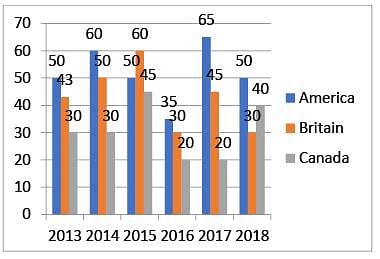
What is the percentage increase in production of America from 2016 to 2017?
Study the following graph carefully to answer the questions given below it.
Production of Wheat (in Lakh tonnes) by three different countries America, Britain & Canada over the years

What is the difference (in Lakh tonnes) between the average production per year of the company with highest average production and that of the company with the lowest average production?
Pointing to a photograph Anjali said, "He is the son of the only son of my grandfather." How is the man in the photograph related to Anjali?
Directions to Solve:
In each of the following questions, you are given a figure (X) followed by four alternative figures (1), (2), (3) and (4) such that figure (X) is embedded in one of them. Trace out the alternative figure which contains fig. (X) as its part.
Question -
Find out the alternative figure which contains figure (X) as its part.

(X) (1) (2) (3) (4)
A, B and C jointly thought of engaging themselves in a business venture. It was agreed that A would invest Rs. 6500 for 6 months, B, Rs. 8400 for 5 months and C, Rs. 10,000 for 3 months. A wants to be the working member for which, he was to receive 5% of the profits. The profit earned was Rs. 7400. Calculate the share of B in the profit.
|
20 tests
|
|
20 tests
|




















